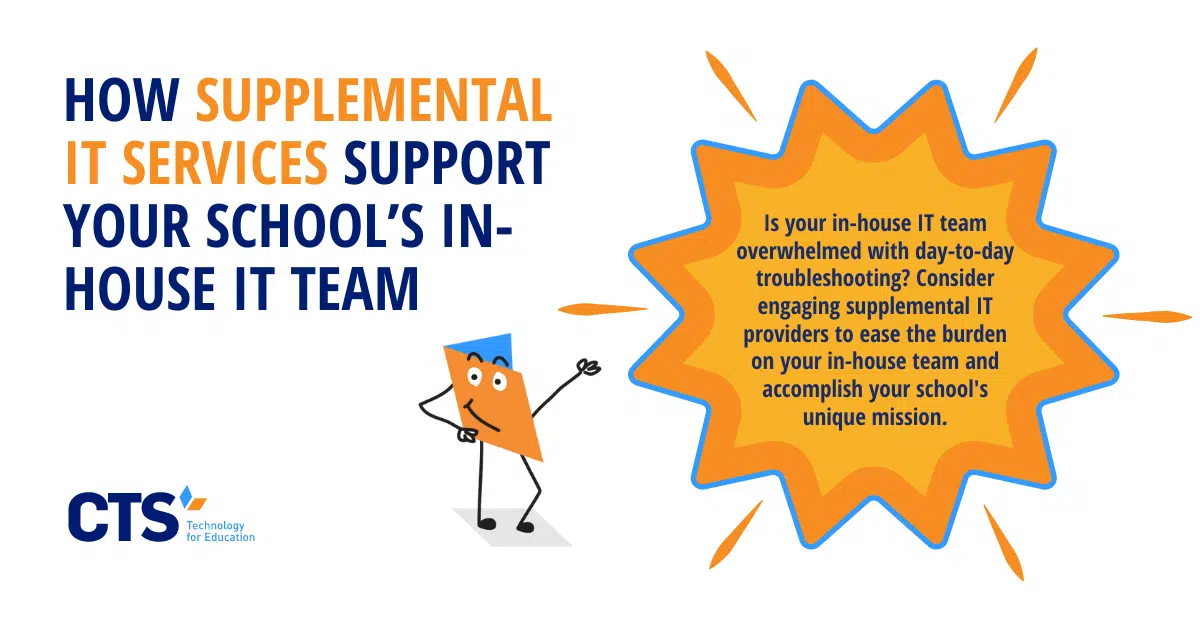In-house IT teams often have more responsibilities than they can reasonably handle.
Imagine a school with an enrollment of 300 students staffed by a single in-house IT team member. The team member’s day will probably begin with a review of any outstanding tickets, which could number in the dozens, a look at their calendar, which could include multiple meetings with teachers or school leadership, and of course two hours blocked for an after-school event that needs audio-visual support. Put all of these responsibilities together and it’s easy to see how in-house IT teams, even those with multiple members, can become overwhelmed with all of their competing priorities.
Troubleshooting alone can drain hours of time an in-house IT team member could spend on longer-term projects. A teacher’s SMART board unexpectedly malfunctions, a student’s Chromebook snaps in half, or the principal is having trouble accessing an online instructional platform: each of these issues can both distract the in-house IT team member from other strategic priorities, as well as potentially take hours of time to resolve.
By partnering with a third-party supplemental IT provider, schools can ease the day-to-day troubleshooting burdens for their in-house team, as well as proactively monitor their critical IT infrastructure to prevent outages and guard against security threats. A supplemental IT team can also tackle complex IT projects that an in-house team lacks the know-how or capacity to complete, all while allowing the in-house team to focus on tasks that add value to instructional programming.
Supplemental IT teams can monitor your school’s critical IT infrastructure.
In-house IT teams often have too many individual fires to put out to proactively monitor the school’s critical IT infrastructure. Ensuring functional wireless access points, routers, switches, servers, and other IT infrastructure is critical to the school’s in-classroom technology programming. If an access point suddenly goes out in the middle of the school day or, worse, a router fails, causing the entire school to lose internet access, teachers and administrators find themselves in a bind, forced to wait until IT fixes the problem before they can resume their work.
By proactively monitoring access points and other critical IT infrastructure, supplemental IT teams can minimize the extent to which these and other potential service outages negatively impact instruction. Additionally, supplemental IT teams have the capacity to actively monitor and proactively guard against potential security threats to the school’s network, giving teachers and families the peace of mind they need to support their students’ online learning.
Supplemental IT teams can provide extra troubleshooting support for a school’s in-house IT team.
Of course, the bulk of the work of an in-house IT team typically centers on troubleshooting. If a student’s device stops working, a projector bulb blows out, or a staff member’s computer needs an upgrade, IT is often their first call. With so few in-house team members and so many teachers and students with potential technology issues, in-house teams can quickly become overwhelmed by the sheer volume of tickets they receive.
By bringing in a supplemental IT team to support the in-house team’s troubleshooting efforts, schools can direct common or “quick fixes” to the supplemental IT team, while reserving only the most complex tickets–or those that require in-person support–to the in-house team. Without the additional burden of low-level, common troubleshooting tickets, the in-house team can more efficiently address the school’s technology issues and have more time to focus on longer-term strategic priorities that can often take a back seat to individual tickets.
Schools can count on supplemental IT teams to tackle their most complex technology projects.
Finally, in-house IT teams might not have all of the answers to a school’s technology problems or can’t effectively perform a particularly complex IT project. In this case, it often makes sense to partner with a third-party provider to handle the problem or perform the project, rather than relying on the in-house team to study up and resolve it themselves. Because they can draw on the expertise of an entire team, supplemental IT firms can often provide a solution to a particularly complex technology problem or project in cases where an in-house team simply can’t. Even where the in-house team has the know-how, the supplemental IT team may simply be able to solve the problem more efficiently and, potentially, at a lower cost if additional purchases are required.
At CTS, we collaborate with in-house IT teams to help schools accomplish their unique missions.
Our team has worked with more than 60 schools across the United States to improve their technology programming. From troubleshooting support, long-term strategic planning, and educational data services, our team can support your school’s in-house IT team so that you can focus solely on instruction. Contact us today to learn more about our services, and how we can support your in-house IT team and accomplish your school’s unique mission.




